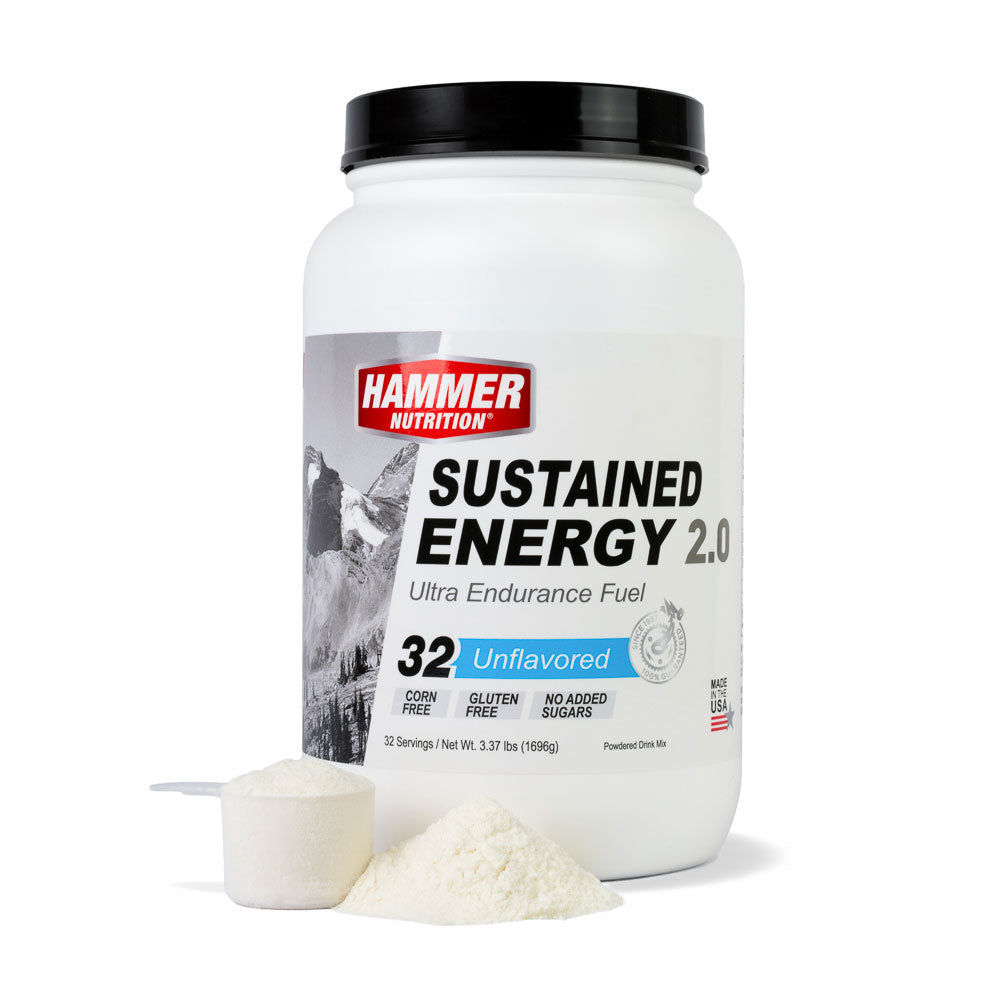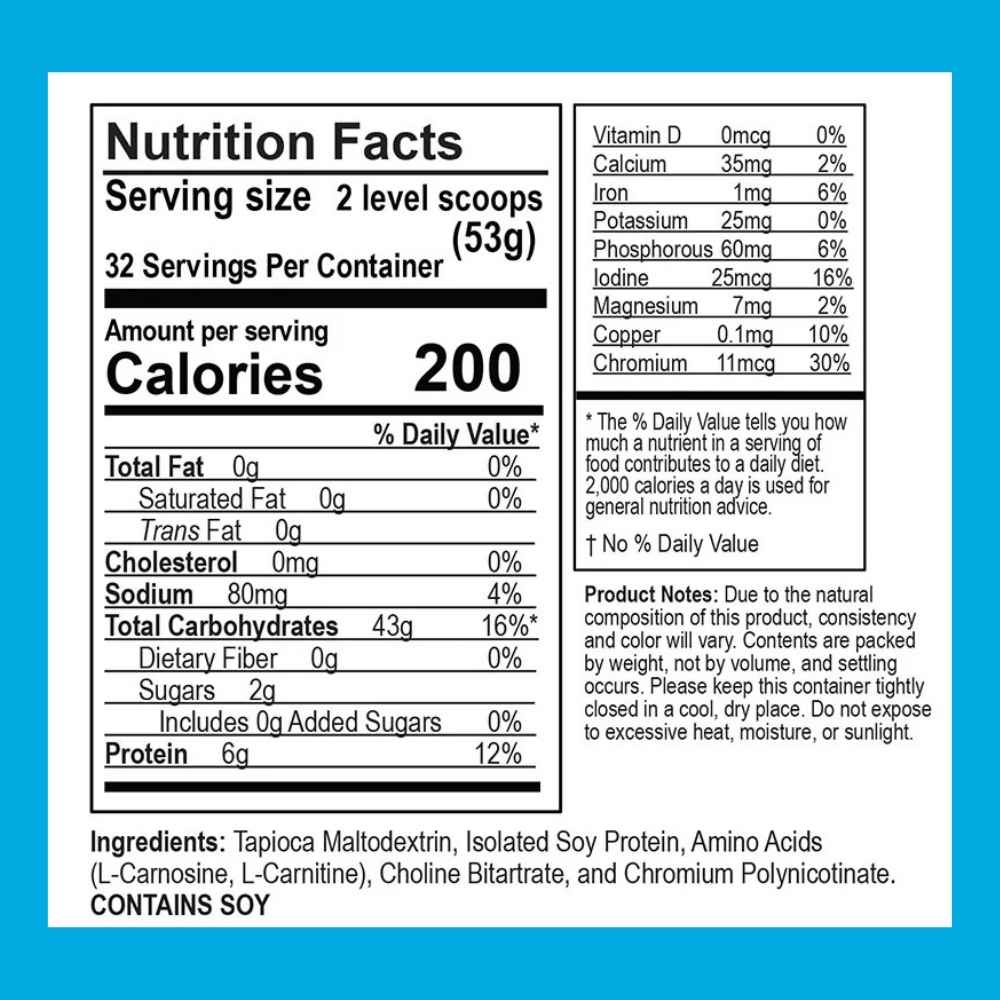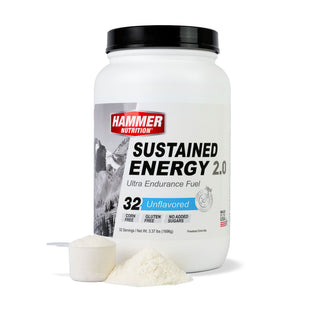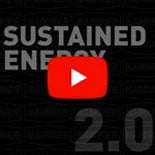









Sustained Energy 2.0
- Stable energy levels, hour after hour
- Non-Acidic, lactic acid buffering
- Spares muscle mass






The world’s first protein-fortified sports drink still stands the test of time. Designed to provide steady energy, buffer lactic acid, and prevent lean-muscle cannibalization, this unsweetened and mild-tasting, 7:1 carb-to-protein blend has been a fan favorite since 1992. 30 years later, we’ve taken it up another huge level by replacing the corn maltodextrin with massively superior tapioca maltodextrin. Superior because of far less processing, guaranteed no GMO content, lower amounts of sodium and higher amounts of naturally occurring potassium, and a more-alkaline pH. Tapioca maltodextrin has the same Glycemic Index (GI) as other forms of maltodextrin, so you get the fast-acting energy that you’re looking for. Coupled with that, tapioca maltodextrin has a lower Dextrose Equivalent (DE), which means more polysaccharide (complex carb) chains for even longer-lasting energy and endurance.
Tapioca is the sugar and corn alternative we’ve been wanting to bring to you for years is finally here!
Whether you’ve been using Sustained Energy for 30 years or are thinking of trying it for the first time, you are going to be impressed with this 2.0 version, guaranteed!
Sustained Energy 2.0 is especially popular with ectomorphic, hyper-metabolic body types with limited fat stores who struggle to maintain muscle mass during high-volume training.
- Why did you switch to a tapioca-derived maltodextrin for Sustained Energy 2.0?
- SHOULD I USE PERPETUEM OR SUSTAINED ENERGY?
- How Should I Mix Perpetuem Or Sustained Energy For A Hot-Weather Event?
- Is It Okay To Mix Perpetuem Or Sustained Energy And Keep It Refrigerated?
- How soon after mixing Perpetuem and Sustained Energy do they need to be consumed?
- How do I determine the equivalent of one scoop of Sustained Energy 2.0?
- Why did the serving size change?
- Can I use Recoverite or Vegan Recoverite during a long workout or event?
- Why do you use maltodextrin instead of sugar in your fuels?
- How can I prevent any clumping from happening when mixing my fuel bottles?
Why did you switch to a tapioca-derived maltodextrin for Sustained Energy 2.0?
Our carbohydrate-containing fuels used a corn-derived maltodextrin (complex carbohydrate), which was actually a very good maltodextrin. However, we found that tapioca (cassava root)-derived maltodextrin offers the following advantages over corn-derived maltodextrin, which is why we made the switch:
- Tapioca requires far less processing than corn.
- Unlike corn, there is no GMO content in tapioca to begin with, so even though all the corn-derived maltodextrin we used in our products tested at 0ppb for GMOs, going with tapioca just saves us that hassle.
- Tapioca maltodextrin has naturally lower amounts of sodium and higher amounts of naturally occurring potassium. Given that most everyone consumes far too much sodium as it is, having more potassium and less sodium is a definite plus.
- Tapioca maltodextrin has a more-alkaline pH than corn-derived maltodextrin. Considering that we athletes are “acid-producing machines” during exercise, a more-alkaline pH is a highly desirable during-exercise feature/benefit.
- Tapioca maltodextrin has a lower Dextrose Equivalent (DE), which means lower mono and disaccharide (short-chain sugar) content, and a much higher percentage of polysaccharide (complex carb) content--in essence, a more “complex” complex carbohydrate--for even longer-lasting energy and endurance.
- Tapioca maltodextrin has same Glycemic Index (GI) as other forms of maltodextrin, so you get the fast-acting energy that you’re looking for.
SHOULD I USE PERPETUEM OR SUSTAINED ENERGY?
Hammer Nutrition offers two superb long-distance fuels in powder form – Sustained Energy 2.0 and Perpetuem 2.0. Sustained Energy 2.0 (“SE” as it’s commonly referred to) was introduced in 1992; Perpetuem first became available in early 2003. The newer 2.0 versions of both fuels were introduced in 2022. Perpetuem 2.0 and Sustained Energy 2.0 are intended to be used as your primary or sole fuel when exercise goes beyond two hours.
Deciding whether to use Sustained Energy 2.0 or Perpetuem 2.0 (or both) will undoubtedly be influenced by personal preference; however, there are a few differences between these two time-proven fuels that can assist you in the selection process.
CALORIES: Every 2-scoop serving of Perpetuem 2.0 contains 180 calories. Sustained Energy 2.0 contains 200 calories per 2-scoop serving.
PRIMARY INGREDIENTS: Sustained Energy 2.0 contains a 7:1 ratio of complex carbohydrates to soy protein and is fat free. Perpetuem 2.0’s carbohydrate-to-protein ratio is approximately 8:1, with 2.0 gramsof healthy fat (soy lecithin, sunflower oil) added to every 2-scoop of the formula.
Three reasons for the inclusion of this specific fat in Perpetuem 2.0 are:
- To act as a natural preservative, increasing the “shelf life” of the carbohydrate and protein components
- To assist the body in more liberally releasing its fatty acids stores, which account for up to two–thirds of one's energy requirements in long bouts of exercise
- To slightly slow the rate of digestion and thus decrease hunger pangs
AUXILIARY NUTRITIENTS: Perpetuem 2.0 contains Sodium Phosphate (aka Sodium Tribasic Phosphate). This nutrient was not added to the Sustained Energy 2.0 formula. Primary among its benefits, Sodium Phosphate is a powerful acid-buffering nutrient, reducing the burning sensation effects of lactic acid buildup. Both fuels contain l-carnosine, which is also an effective acid-buffering/pH-neutralizing compound.
FLAVORS: Sustained Energy 2.0 has always come in a neutral (“plain”) flavor. Perpetuem 2.0 comes in four flavor options—orange, strawberry, chocolate, and caffe latte (includes 15 mg of caffeine per scoop).
OTHER FACTORS TO CONSIDER
We have noted that Sustained Energy 2.0 may be the ideal fuel choice when endurance exercise intensity is at a higher level (approximately 70–85% MHR), whereas Perpetuem 2.0 may be a more attractive choice the longer the athlete goes and when exercise intensity is at a more aerobic pace (under 70% MHR). Additionally, over the course of many years we have noted that Sustained Energy 2.0 may be the best option for very lean athletes (the “high metabolizer/hyper–metabolic” types), while Perpetuem 2.0—with its added healthy fat component—may be more appropriate for athletes with a naturally higher body fat percentage. The rationale for this suggestion is that athletes with a higher body fat percentage have a greater volume of calories available from body fat stores, which the healthy fat in Perpetuem 2.0 may effectively assist in accessing for use as energy.
Bottom line: With Perpetuem 2.0 and Sustained Energy 2.0 you have two great long distance fuel choices. When exercise goes beyond about two hours, you can use either product as your sole fuel, in tandem with each other, or as your primary fuel along with any of the other Hammer Nutrition fuels. Taking into account the earlier-listed differences between the products, as well as testing each product under a variety of conditions in your long–duration workouts, will allow you to determine which fuel works best for you.
How Should I Mix Perpetuem Or Sustained Energy For A Hot-Weather Event?
If the weather is going to be mild-to-warm you should make your multi-hour bottle(s) of Perpetuem or Sustained Energy the night before and freeze them. If, for example, you’re doing an iron-distance triathlon you can put both bottles on the bike or leave one at Special Needs. If you’re doing a 6-hour cycling event, you can carry both bottles on the bike. If you’re doing an ultrarunning race, you can carry one and have the other in a small cooler at the “bag drop” aid station.
If it’s going to be hot on your iron-distance triathlon, freeze your first multi-hour bottle of Perpetuem or Sustained Energy. Freeze the second bottle as well, but prior to putting it in the freezer, wrap a wet face cloth or rag around the bottle and secure with a couple rubber bands… then stick it in the freezer. This second bottle will end up having a frozen face cloth/rag around it, which provides extra insulation to help keep it cool. This second bottle will go to Special Needs. This is also a good strategy for ultrarunners who have a “bag drop” aid station. Carry the first frozen multi-hour bottle with you, and pick up the wrapped-frozen multi-hour bottle at the bag drop aid station.
If the weather is going to be extremely hot on event day, make up and freeze your first multi-hour bottle of Perpetuem 2.0 or Sustained Energy 2.0 and carry with you on bike or body. Have the second one waiting for you, dry powder only in a bottle at Special Needs (triathlon), on your bike (cycling events), or at the “bag drop” aid station (ultrarunning). You will have to stop briefly to add cold water to the powder-only bottle and spend a little time getting it mixed. However, this is time well invested because you will have a fresh bottle of cold fuel to cover you for the next several hours.
Is It Okay To Mix Perpetuem Or Sustained Energy And Keep It Refrigerated?
It is perfectly acceptable to mix bottles of Perpetuem or Sustained Energy ahead of time, though for maximal potency we recommend consuming the pre-mixed bottle(s) within 48 hours’ time once mixed. Freezing the mixture is also completely acceptable, and there is no time limit on when you need to consume frozen Perpetuem or Sustained Energy. You may notice a small amount of crystals at or around the top of the bottle. This is due to the l-carnitine component in these two fuels, which is very hygroscopic (has an affinity for water). L-carnitine formed crystals may signal a slight reduction in potency of this amino acid; however, this crystallization effect is normal and harmless, and the product is perfectly acceptable for consumption.
How soon after mixing Perpetuem and Sustained Energy do they need to be consumed?
In moderate temperatures, a pre-mixed bottle of Perpetuem or Sustained Energy should be suitable for consumption for up to 5 hours, perhaps even slightly longer. In warm-to-hot weather, that consumption “window” will be shorter, as short as 2 hours in very warm weather. Freezing your pre-mixed bottle(s) of fuel the night before will extend their palatability (i.e., staying colder longer) and keep the mixture suitable for consumption for a longer period of time.
How do I determine the equivalent of one scoop of Sustained Energy 2.0?
No scoop? No problem! With the following conversion information, your "Where did my scoop go?" problems are resolved!
Sustained Energy
1 Level Scoop (50 cc) = 3 TBSP + 1 tsp (Serving Size: 2 Scoops)
Why did the serving size change?
The original 320 calorie "mega" serving was way too big, which is the exact opposite of what we advocate - Less is best. In fact, about the only complaints we ever got was from over consuming. 180 calories per hour is much more in line with what most athletes find works best, with some needing a little less and some needing a little more. Starting with one serving per hour and adjusting up or down for individual needs makes things a lot easier to find your ideal hourly caloric intake.
For those wanting to get back to the original serving size, it’s easy. Each scoop is 100 calories, so three scoops will almost give you the same amount of calories.
Can I use Recoverite or Vegan Recoverite during a long workout or event?
There are two things about Recoverite and Vegan Recoverite that make them not good choices for use during exercise:
1) The carb to protein ratio in Recoverite is 3:1, which, while not harmful, is not ideal during exercise. During exercise only a small portion of the body’s energy requirements—somewhere between 8% - 12%—need to be fulfilled via protein. With that being the case, the carb to protein ratio should be skewed much more in favor of carbohydrates than protein, with a 7:1 or 8:1 ratio being ideal. This is where our long-distance fuels come in— Perpetuem and Sustained Energy.
2) The l-glutamine (aka glutamine) that we add to the product is the primary issue. Glutamine is an incredibly beneficial amino acid, but it’s not ideal to consume it prior to or during exercise, as it will produce some ammonia when it’s first metabolized. After exercise, when the muscles are no longer actively working, this is not problematic at all, and all the benefits that glutamine provides can be enjoyed. During exercise, however, you are already producing ammonia (it can’t be completely avoided), which is a primary cause of fatigue, and you don’t want to do anything to exacerbate the problem. But that’s exactly what happens when you consume glutamine supplements or glutamine-enhanced fuels during exercise... you increase the body's ammonia "burden." Interestingly, in about 3-hours’ time, glutamine actually becomes an effective ammonia scavenger, neutralizing/detoxifying the ammonia it produces, and then some. The problem is that during exercise you don’t have the luxury of waiting 3 hours for glutamine to scavenge ammonia the ammonia it initially produces and more.
For best results, use Perpetuem or Sustained Energy during exercise and save Recoverite for after your workouts.
Why do you use maltodextrin instead of sugar in your fuels?
Here are the benefits of maltodextrin, along with information about its effects on insulin during exercise and shortly after it’s been completed.
The Benefits of Maltodextrin
- You can digest greater amounts of calories from maltodextrin than from any short-chain sugar, aka “simple sugar,” such as glucose, sucrose, and fructose (As one nutritional scientist states, “maltodextrin allows one to swallow more energy in less volume.”) With maltodextrin you get the full amount of calories that you need for energy production, and with no delay in exiting the GI tract. Fuels containing simple sugars much be mixed at very calorically weak solutions in order to be digested with any efficiency, so your body won’t be getting the right amount of calories it needs. However, when athletes try to make a “double-strength” mix of a simple sugar fuel, that too-high sugar mixture does not match body fluid chemistry, which means it just sits in the stomach undigested for a lengthy period of time... and that means severe stomach distress. You won’t have that issue with maltodextrin.
- Maltodextrin goes to work extremely quickly in producing energy because it’s a high Glycemic Index carbohydrate; in fact, it’s the same as pure glucose (both are 100). That’s a good thing because you want that energy as quickly as possible, and that’s what maltodextrin will do. Another benefit with maltodextrin is that, because it’s comprised of hundreds of saccharide molecules all weakly bonded together, it will provide a much more consistent and longer-lasting energy than glucose or any other simple sugar, and without that undesirable “peak and valley”, “flash and crash” energy that is typical with simple sugars.
Because of maltodextrin’s high Glycemic Index (GI), many people ask about the insulin release that occurs. The answer to that is that, yes, maltodextrin does elevate blood sugar levels very rapidly and will cause an insulin release. This is not an issue immediately prior to exercise, during exercise, however, as Dr. Misner explains: "During exercise, insulin release is inhibited because sympathetic nervous system hormones are also released and, concurrently, exercise augments muscle uptake of glucose from exogenous intake accompanied by lower insulin levels and effects." Basically, what Dr. Misner is saying is that because energy turnover is very high, and with the release of specific central nervous system hormones, the body is able to deliver glucose to the muscles with very minimal insulin… insulin release is not a significant factor during exercise.
After exercise, when the body needs to have its cells restocked with fuel, maltodextrin’s high Glycemic Index is also desirable… Recoverite and Organic Vegan Recoverite are PERFECT fuels for maximizing recovery.
Those are the only three times—immediately prior to exercise, during exercise, and shortly after exercise—when a high-GI carbohydrate such as maltodextrin should be consumed.
How can I prevent any clumping from happening when mixing my fuel bottles?
Always start with about one-third of your water bottle/blender bottle filled with water. Adding water to dry powder will oftentimes cause clumping, but if you first start with water and then add the powder, this issue will cease to exist. Once you’ve added the powder to the water-containing bottle, put the lid on and shake vigorously. After that, add a bit more water, put the lid on, and repeat the process. Continue until your fuel bottle is full. Note: This is especially important when you’re making a multi-hour bottle of fuel; make it a little bit at a time—add some water, add powder, put the lid on, shake, repeat.
1-Hour Bottle
Mix 1–2 scoops to 12-20 oz. (355 – 591 ml) of water and consume entire contents each hour. Only supplemental electrolytes are needed here.
Multi-Hour Bottle
Mix 1–2 scoops per hour of planned exercise, up to 8 scoops in a large water bottle. Drink gradually over the desired number of hours.
Paste
Mix 1–3 scoops in a bowl with a small amount of water, stir, and mix until the combination forms a paste. Fill a flask or other container with paste. Use as desired during exercise as a source of calories only.
NOTES ON MULTI-HOUR AND PASTE
When consuming in this manner, it’s not a source of hydration, just calories. You must have a separate, plain water source for your hydration needs. You must also consume electrolytes from an independent source.
PRO TIP
For exercise lasting three hours or more, use from the outset.
Sustained Energy 2.0 contains no artificial preservatives. To avoid spoilage, do not premix or leave unrefrigerated, especially in warm weather.
Tapioca Maltodextrin – A high-glycemic index (GI) complex carbohydrate, ideal for providing fast-acting, long-lasting energy during exercise.
Isolated Soy Protein – A dry powder food ingredient that has been separated or isolated from the other components of the soybean, making it 90 to 95 percent protein, and nearly carbohydrate- and fat-free.
L-Carnosine – This dipeptide (a combination of two amino acids) L-carnosine is a potent lactic acid buffer. It also offers antioxidant support.
L-Carnitine Tartrate – L-Carnitine Tartrate is a compound containing L-carnitine chelated (“bonded”) to L-tartrate, which is a salt of tartaric acid. L-carnitine is the key nutrient involved in the shuttling of fatty acids into the cell for energy production. Tartrate is a potent antioxidant.
Choline Bitartrate – A type of B-complex vitamin that helps with efficient use of body fat stores as energy. Choline bitartrate also supports enhanced cognition, learning, and memory.
Chromium Polynicotinate – This trace mineral helps regulate blood sugar and plays a vital role in energy production.
| Sustained Energy 2.0 Nutrition Facts |
||
|---|---|---|
| Serving Size: 53g (2 Level Scoops) | ||
| Amount Per Serving | % Daily Value* | |
| Calories | 200 | |
| Total Fat | 0g | 0% |
| Saturated Fat | 0g | 0% |
| Trans Fat | 0g | |
| Cholesterol | 0mg | 0% |
| Sodium | 80mg | 4% |
| Total Carbohydrate | 43g | 16% |
| Dietary Fiber | 0g | 0% |
| Total Sugars | 2g | |
| Added Sugars | 0g | 0% |
| Protein | 6g | 12% |
| Vitamin D | 0mcg | 0% |
| Calcium | 35mg | 2% |
| Iron | 1mg | 6% |
| Potassium | 25mg | 0% |
| Phosphorus | 60mg | 6% |
| Iodine | 25mcg | 16% |
| Magnesium | 7mg | 2% |
| Copper | 0.1mg | 10% |
| Chromium | 11mcg | 30% |
| *Percent Daily Values are based on a 2,000 calorie diet. | ||
| Ingredients: Tapioca Maltodextrin, Isolated Soy Protein, Amino Acids (L-Carnosine, L-Carnitine), Choline Bitartrate, Chromium Polynicotinate. | ||
| Contains:Soy | ||
| This product is processed in a facility that also processes dairy, egg, and wheat products. | ||



